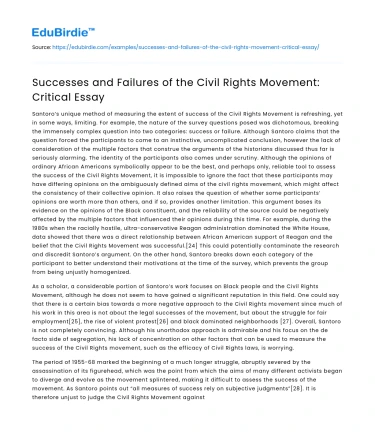Santoro’s unique method of measuring the extent of success of the Civil Rights Movement is refreshing, yet in some ways, limiting. For example, the nature of the survey questions posed was dichotomous, breaking the immensely complex question into two categories: success or failure. Although Santoro claims that the question forced the participants to come to an instinctive, uncomplicated conclusion, however the lack of consideration of the multiple factors that construe the arguments of the historians discussed thus far is seriously alarming. The identity of the participants also comes under scrutiny. Although the opinions of ordinary African Americans symbolically appear to be the best, and perhaps only, reliable tool to assess the success of the Civil Rights Movement, it is impossible to ignore the fact that these participants may have differing opinions on the ambiguously defined aims of the civil rights movement, which might affect the consistency of their collective opinion. It also raises the question of whether some participants’ opinions are worth more than others, and if so, provides another limitation. This argument bases its evidence on the opinions of the Black constituent, and the reliability of the source could be negatively affected by the multiple factors that influenced their opinions during this time. For example, during the 1980s when the racially hostile, ultra-conservative Reagan administration dominated the White House, data showed that there was a direct relationship between African American support of Reagan and the belief that the Civil Rights Movement was successful.[24] This could potentially contaminate the research and discredit Santoro’s argument. On the other hand, Santoro breaks down each category of the participant to better understand their motivations at the time of the survey, which prevents the group from being unjustly homogenized.
As a scholar, a considerable portion of Santoro’s work focuses on Black people and the Civil Rights Movement, although he does not seem to have gained a significant reputation in this field. One could say that there is a certain bias towards a more negative approach to the Civil Rights movement since much of his work in this area is not about the legal successes of the movement, but about the struggle for fair employment[25], the rise of violent protest[26] and black dominated neighborhoods [27]. Overall, Santoro is not completely convincing. Although his unorthodox approach is admirable and his focus on the de facto side of segregation, his lack of concentration on other factors that can be used to measure the success of the Civil Rights movement, such as the efficacy of Civil Rights laws, is worrying.
Save your time!
We can take care of your essay
- Proper editing and formatting
- Free revision, title page, and bibliography
- Flexible prices and money-back guarantee
The period of 1955-68 marked the beginning of a much longer struggle, abruptly severed by the assassination of its figurehead, which was the point from which the aims of many different activists began to diverge and evolve as the movement splintered, making it difficult to assess the success of the movement. As Santoro points out “all measures of success rely on subjective judgments”[28]. It is therefore unjust to judge the Civil Rights Movement against the harsh dichotomy of failure and success or to grow frustrated with the lack of immediate revolutionary change in America.
It is more prudent to, like Minchin, acknowledge that this period of the Civil Rights movement, through its pursuit of de jure desegregation, contributed to the security of Black opportunity in the mainstream world, whilst the second phase of what Black Power Historian Peniel E. Joseph termed a wider “Black freedom struggle” is tasked with finishing the pursuit of equality of Black result, or the desired outcome. In general, the period of 1955-1968 saw the ambitious attempt of many African Americans to uproot centuries of white supremacy, and their struggle should not be seen as entirely fruitless. As Vincent Harding once declared at a gathering of the Student Non-violent Coordinating Committee (SNCC) in 1978, ‘if anyone present doubted what the movement had accomplished he or she 'had forgotten what life was like in a Jim Crow America where lynchings went unpunished and terror was everywhere”’.






 Stuck on your essay?
Stuck on your essay?

